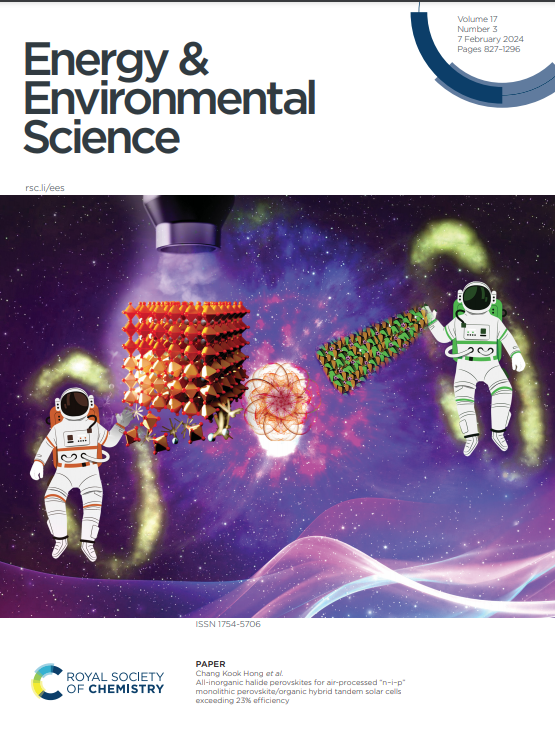Synergistically enhancing the selective adsorption for crystal planes to regulate the (002)-texture preferred Zn deposition via supramolecular host-guest units
IF 32.4
1区 材料科学
Q1 CHEMISTRY, MULTIDISCIPLINARY
引用次数: 0
Abstract
Uncontrollable dendrite growth and parasitic reactions lead to poor reversibility of zinc (Zn) anodes, which seriously hinders the commercialization of aqueous Zn metal batteries. A promising strategy to address these issues is to rationally regulate the preferred orientation of crystal planes and form compact layers during the deposition process. Herein, the host-guest interaction in supramolecular chemistry is reported to induce (002)-texture preferred Zn deposition. It is demonstrated that the supramolecular complex units synergistically enhance the selectivity and adsorption ability for Zn crystal planes, facilitating homogeneous Zn(002) deposition at high current densities and areal capacities. Meanwhile, the steric hindrance at the interface of the order-anchored supramolecular complex units on the Zn surface not only constructs a water-poor microenvironment to effectively inhibit aggressive side reactions, but also functions as an ionic buffer zone to moderate the rapid electrochemical redox kinetics, thus homogenizing the ionic fluid and electric field. Benefitting from the above advantages of the supramolecular complex units, the assembled Zn symmetric cell exhibits remarkable cycling stability (5800 h, equal to 241 days). In the cyclic-intermittent testing mode, the symmetric cell still operates stably with a cumulative resting time of 1750 h, showing an exceptional anti-calendar aging performance. Furthermore, the assembled Zn/MnO2 pouch cell achieves a long lifespan (1000 cycles at 1 A g−1) with a capacity retention of 84.9%. Therefore, this strategy of constructing supramolecular complex units to regulate the crystal orientation is expected to shed new light on aqueous battery chemistry.通过超分子主客体单元协同增强对晶面的选择性吸附,从而调节 (002) 纹理优先的锌沉积
不可控的枝晶生长和寄生反应导致锌(Zn)阳极的可逆性差,严重阻碍了锌金属水电池的商业化。解决这些问题的一个可行策略是在沉积过程中合理调节晶面的优先取向并形成致密层。本文报告了超分子化学中的主客体相互作用诱导 (002)- 纹理优先的锌沉积。研究表明,超分子复合物单元协同增强了对锌晶面的选择性和吸附能力,从而促进了高电流密度和高面积容量下的均匀锌(002)沉积。同时,Zn 表面的有序锚定超分子复合物单元界面上的立体阻碍不仅构建了一个贫水的微环境,有效抑制了侵蚀性副反应,还起到了离子缓冲区的作用,缓和了快速的电化学氧化还原动力学,从而均匀了离子液体和电场。得益于超分子复合物单元的上述优势,组装好的锌对称电池表现出显著的循环稳定性(5800 小时,相当于 241 天)。在循环-间歇测试模式下,对称电池在累计静置 1750 小时后仍能稳定工作,显示出卓越的抗日历老化性能。此外,组装好的 Zn/MnO2 袋状电池实现了较长的使用寿命(在 1 A g-1 条件下循环 1000 次),容量保持率高达 84.9%。因此,这种构建超分子复合单元以调节晶体取向的策略有望为水性电池化学带来新的启示。
本文章由计算机程序翻译,如有差异,请以英文原文为准。
求助全文
约1分钟内获得全文
求助全文
来源期刊

Energy & Environmental Science
化学-工程:化工
CiteScore
50.50
自引率
2.20%
发文量
349
审稿时长
2.2 months
期刊介绍:
Energy & Environmental Science, a peer-reviewed scientific journal, publishes original research and review articles covering interdisciplinary topics in the (bio)chemical and (bio)physical sciences, as well as chemical engineering disciplines. Published monthly by the Royal Society of Chemistry (RSC), a not-for-profit publisher, Energy & Environmental Science is recognized as a leading journal. It boasts an impressive impact factor of 8.500 as of 2009, ranking 8th among 140 journals in the category "Chemistry, Multidisciplinary," second among 71 journals in "Energy & Fuels," second among 128 journals in "Engineering, Chemical," and first among 181 scientific journals in "Environmental Sciences."
Energy & Environmental Science publishes various types of articles, including Research Papers (original scientific work), Review Articles, Perspectives, and Minireviews (feature review-type articles of broad interest), Communications (original scientific work of an urgent nature), Opinions (personal, often speculative viewpoints or hypotheses on current topics), and Analysis Articles (in-depth examination of energy-related issues).
 求助内容:
求助内容: 应助结果提醒方式:
应助结果提醒方式:


